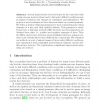Free Online Productivity Tools
i2Speak
i2Symbol
i2OCR
iTex2Img
iWeb2Print
iWeb2Shot
i2Type
iPdf2Split
iPdf2Merge
i2Bopomofo
i2Arabic
i2Style
i2Image
i2PDF
iLatex2Rtf
Sci2ools
IBERAMIA
2010
Springer
2010
Springer
A Visual Grammar for Face Detection
Several methods have been developed for face detection with certain success, however these tend to fail under difficult conditions such as partial occlusions and changes in orientation and illumination. We propose a novel technique for face detection based on a visual grammar. We define a symbol relational grammar for faces, representing the visual elements of a face and their spatial relations. This grammar is transformed into a Bayesian network (BN) structure and its parameters are obtained from data, i.e., positive and negative examples of faces. Then the BN is used for face detection via probabilistic inference, using as evidence a set of weak detectors for different face components. We evaluated our method on a set of sample images of faces under difficult conditions, and contrasted it with a simplified model without relations, and the AdaBoost face detector. The results show a significant improvement when using our method.
| Added | 25 Jan 2011 |
| Updated | 25 Jan 2011 |
| Type | Journal |
| Year | 2010 |
| Where | IBERAMIA |
| Authors | Augusto Meléndez, Luis Enrique Sucar, Eduardo F. Morales |
Comments (0)

